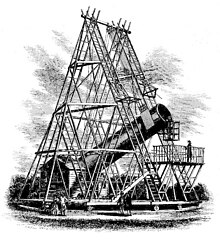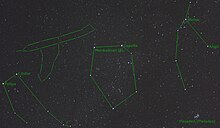Herschel's telescope (constellation)
The constellation Herschels Telescope ( lat. Telescopium Herschelii ) is a constellation of the northern sky that is not one of the 88 constellations recognized by the International Astronomical Union (IAU) .
Herschel's telescope is mainly located in the eastern part of what is now the official constellation Fuhrmann , and northwest of Castor and Pollux , in the constellation Gemini . With the exception of the open star cluster NGC 2281 , the constellation only consists of very faint stars up to a maximum of 5 m in size .
The constellation was introduced as Herschel's large telescope (Tubus Herschelii Major) and Herschel's small telescope (Tubus Herschelii Minor) by the Austrian astronomer and priest Maximilian Hell in 1789, in memory of the telescope with which William Herschel discovered the planet Uranus in 1781 . Johann Elert Bode summarized it under Telescopium in 1801 .

Web links
- http://www.pa.msu.edu/people/horvatin/Astronomy_Facts/obsolete_pages/telescopium_herschelii.htm
- http://www.ianridpath.com/startales/telher.htm
Individual evidence
- ↑ Klaus Beuermann: The Herschels - a Hanoverian family of astronomers in England. P. 251, In: Göttinger Bibliotheksschriften 31 , GOEDOC, University of Göttingen p. 245–261 Web document , PDF 2.8 MB - there also a picture of a small reflector telescope around 1785. Göttingen University Observatory: Inv.-Nr. G.005, Fig. 28, p. 249

